
We may receive commissions from purchases made through links in this post, at no additional cost to you.
Training wheels have been around forever. I know I had them when I was a kid (as did every other kid on the street), and I’m willing to bet most of you had them too. When it was time for my kids to learn to ride a bike, you can bet the first thing I did was buy a set of training wheels.
The big day came for my kids to start riding their bikes and the experience was… terrible. Any time there was the slightest bump in the road, they crashed. Whenever they tried to turn, they crashed. Whenever they gained momentum, they crashed. They crashed a lot.
And this wasn’t just on the first day. We practiced riding a lot with similar results. The one thing my kids didn’t do was learn to ride a bike, and they definitely didn’t have fun.
The experience had me questioning whether training wheels actually work. In fact, did they even work for me? The details might be a little fuzzy (I’m old, so it’s been a while), but I can remember using training wheels, and then I remember it being a long time before I could actually ride a bike.
The more I researched the subject, the more I found that other parents had similar experiences. And while training wheels have been around forever (and may have worked for some people), the truth is they aren’t very good at teaching your child to ride a bike. Let’s take a look at some of the reasons why, and what to use instead.
This article is originally from www.dadstuffsite.com
1. They don’t teach you how to balance
The theory behind training wheels is that you begin by setting them lower to the ground. The back wheel and both training wheels should not be touching the ground at the same time. Instead, the training wheels should be a little higher than the rear wheel.
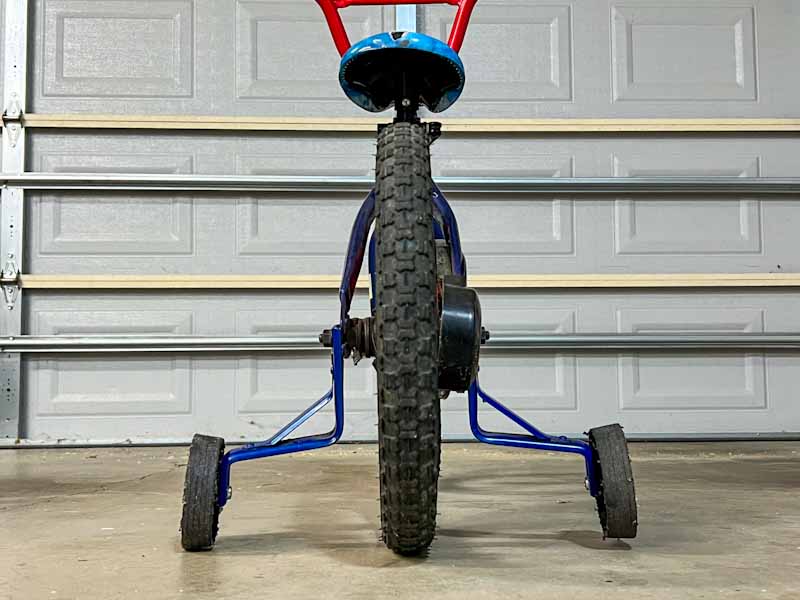
As a child learns the mechanics of pedaling, they also practice balancing. The training wheels are supposed to only catch them if they’re off balance. When your child gets more comfortable, you gradually raise the training wheels higher until you no longer need them.
Except it doesn’t usually work that way in practice. More often, kids will lean into the training wheels to hold themself up. Instead of learning to balance, they create a habit out of riding a bike tilted to the side.
Raising the training wheels higher doesn’t fix the problem. Often, your child will be so accustomed to leaning on the training wheels that they lean farther to find it. Training wheels sound like a great way to learn balance in theory, but in practice, they don’t work.
Related: 5 Alternatives to Using Training Wheels
2. They focus on pedaling, not balancing
The fundamentals of riding a bike can be broken into three basic concepts: Pedaling, balancing, and steering. Training wheels are good at helping kids to learn the concept of pedaling on a bike.
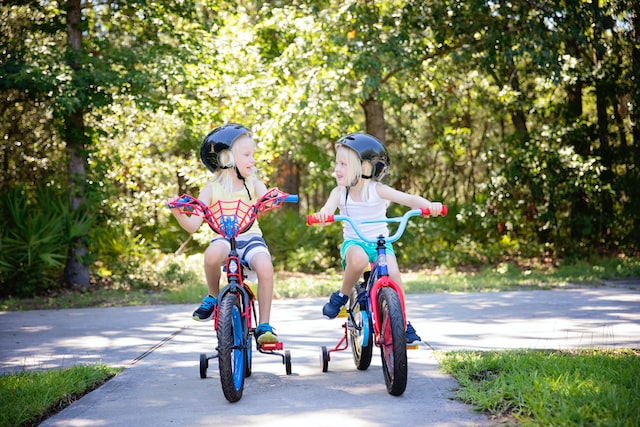
The truth is, pedaling isn’t that hard a concept to teach kids. This is why so many toddlers can ride a tricycle with little explanation. Simply tell them to put their feet on the pedals and push them with their feet. More often than not, they start doing it on their own. This is why you can find so many “how to ride a bike” videos on YouTube and not nearly as many on “how to ride a tricycle.”
The most important (and the most difficult) bike-riding concept is balance. More often than not, children are more successful learning to pedal after learning to balance than the other way around.
In fact, if a beginner knows how to balance on a bike, they often need very little instruction to learn to pedal. Therefore, a better progression for learning to ride a bike is to learn balancing, steering, then pedaling in that order.
3. They don’t follow a child’s natural learning process
Not to get too into the weeds with regard to learning theory, but we generally learn new concepts by starting with something familiar. It is good to tie in a new concept with something a learner is familiar with. Once they are more comfortable with one new concept, introduce the next new concept.
The challenge with learning to ride a bike is that it is completely foreign to a beginner. Balance, pedaling, and steering are things your child most likely have not experienced. Since balance is the most important concept to learn to be successful (and training wheels focus on pedaling, not balance), we need to find a way to tie in something familiar.
Not to give away the final section of this article, but balance bikes are a much better way to teach balance because you start by walking on a bike. If your child is learning to ride a bike, I’m assuming they know how to walk by now. This is a much better bridge to learning balance.
To learn about more alternatives to training wheels, check out Balance Bike vs Bike Without Pedals (What’s Better?)
4. They don’t teach a child to steer properly
The problem with training wheels is that they essentially turn a bike into a tricycle (admittedly, larger and differently balanced). Because training wheels make contact on the ground with the back wheel (even if it’s set up properly slightly higher than the rear wheel), they still function more similarly to a tricycle.
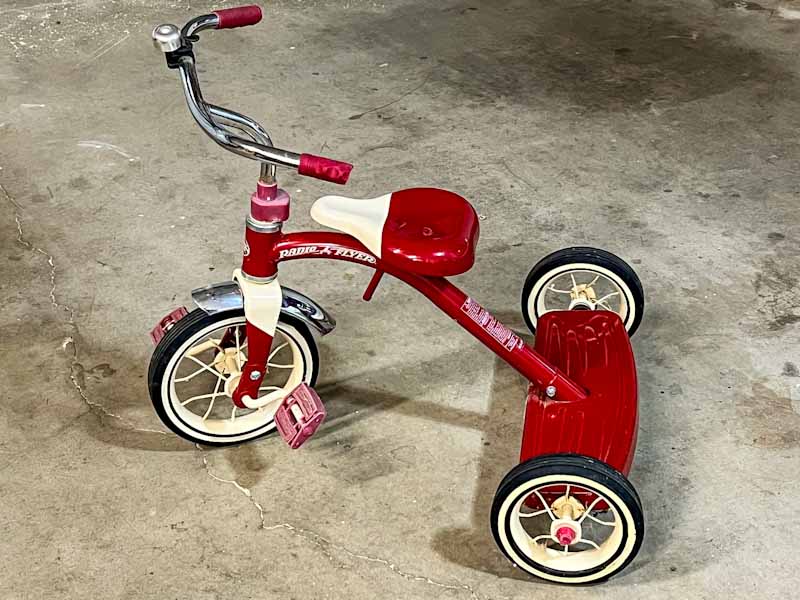
Steering on a bike is different than steering on a tricycle. To steer on a tricycle , you simply turn the handle bars. To turn on a bike, however, you need to learn to lean into a turn.
Because training wheels make contact with the ground when a beginner leans to the side, they ultimately prohibit the rider to learn to lean into a turn. Instead, the beginner needs to turn by using the handle bars.
This is a terrible habit to learn, and one your child is going to have to unlearn. Otherwise, once you remove the training wheels, your child is going to jerk the handle bars and crash.
This article is originally from www.dadstuffsite.com
5. They don’t fit the physical needs of young children
Most pedal bikes aren’t designed well for young children. Because of the pedaling mechanisms, the seat on an average 12” pedal bike (the smallest you can get) can only be lowered to about 17”. The average balance bike can have a seat as low as 10” off the ground.
This is important for two reasons. First, a lower center of gravity is easier for a child to balance. Second, a higher seat means it’s more uncomfortable for your child to catch themself when they lose balance.
It’s important to set the seat properly for your child’s height. Proper height is different whether your child is learning to ride a balance bike, vs their first pedal bike, vs their second pedal bike. Often, a pedal bike will not accommodate the needs of a young child.
If you’re interested in learning more about seat heights, take a look at Best Bike Seat Height for Kids.
6. Pedal bikes are too heavy for young children
Pedal bikes with training wheels are heavy, especially compared to their balance bike counterparts. This is especially important for younger children because many are not strong enough to manage a pedal bike without difficulty.
Most balance bikes are about half the weight of the average pedal bike with training wheels. This makes handling and maneuvering a pedal bike much more difficult. Not only is it harder to handle the weight, but any sort of an incline means a lot more effort to pedal.
When you put all of this together, it often makes the overall experience difficult and uncomfortable. My own kids (and they were 7 and 9 at the time) were much more inclined to give up because of the effort needed to use a heavier pedal bike.
7. Once you take them off, you’re starting all over again
The truth about training wheels is the moment you decide your child is ready to have them taken off, you need to start over again. Remember that training wheels focus on pedaling, so they have not learned to balance.
Taking the training wheels off means you now need to teach them to balance. If training wheels taught balance in the way they theoretically should (see reason 1 again if you want a reminder), then taking them off wouldn’t be the ordeal it always is.
The worst part about it is now your child has gotten used to having the training wheels and the sense of security they give. Without them they’re more afraid. You’ve given them a safety net that you need to take away.
Related: Should Kids Bike With or Against Traffic (And Why)
8. They are slow
Training wheels make riding a bike a slow and awkward experience. Beginners are often riding while leaning into one of the training wheels. This creates a significant amount of drag because small plastic wheels don’t roll as smoothly on pavement as larger, air-filled rubber tires. Even the smallest amount of roughness in the road will create a lot of friction.
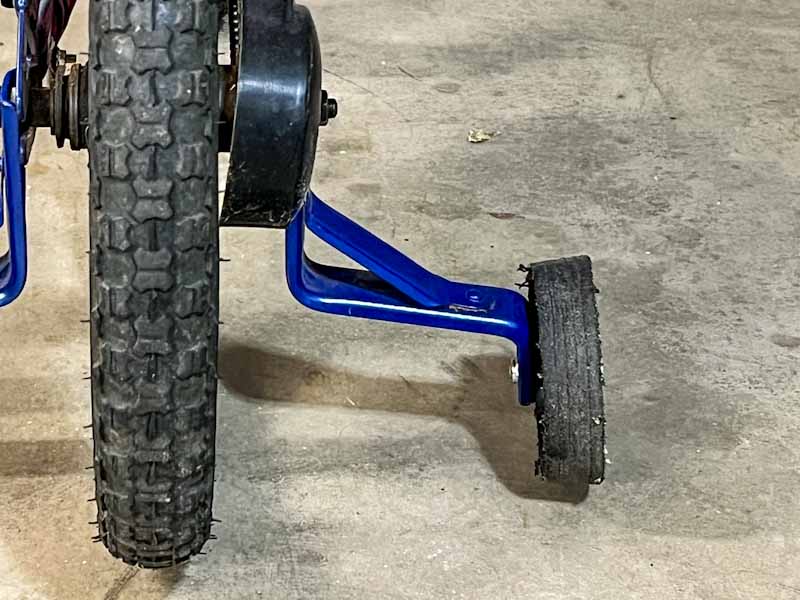
Also, because the focus ends up being on pedaling and not balancing, beginners feel awkward as they ride out of balance. They don’t feel comfortable enough to go much faster.
Not only is this less fun, but it takes a certain amount of speed to comfortably balance on a bike. Otherwise we would teach balance without moving at all. If you cannot get to that minimum threshold of speed, you’re not going to be able to balance on a bike.
This article is originally from www.dadstuffsite.com
9. They don’t scale properly for larger bikes
As your child gets older and bigger, obviously the bike needs to also get bigger. The problem with training wheels for an older child is that they aren’t proportionally large enough to hold their weight.
I learned this lesson teaching my oldest son to ride his bike. When my youngest was riding with training wheels and leaned to the side, the training wheel caught his weight. My oldest (9 at the time) would lean into the training wheel and would come close to crashing each time.
The bike and rider make a kind of lever between the bike and training wheel. So while the training wheels on his bike are larger, the amount of force my son exerts onto the training wheel is considerably larger than my younger son.
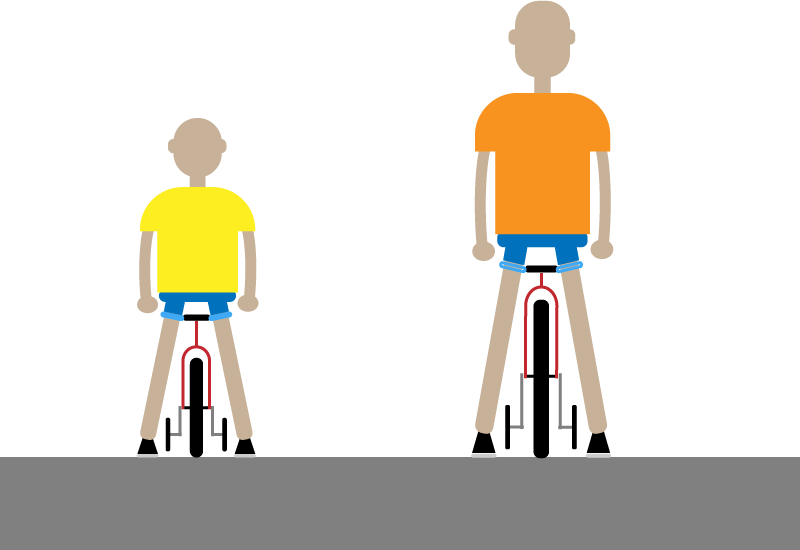
The answer to getting training wheels for an older/larger kid is to get special training wheels. These kind of training wheels are larger and are made with rubber tires. They attach to the frame of the bike so they’re incredibly strong. They are designed to fit a 20” bike and I’m sure they’re great.
The problem is they cost almost $250. I love my kids and all, but I’m not about to drop that kind of money for a temporary solution (especially since they aren’t nearly as effective as other ways to learn to ride a bike).
Related: Can Kids Bike in Flip Flops? (9 Reasons It’s a Bad Idea)
10. They don’t do well on uneven or rough surfaces
Most training wheels are made with plastic wheels. The issue with this is that they create a significant amount of drag even on the smoothest of pavements. They become completely useless on anything less than a paved surface.
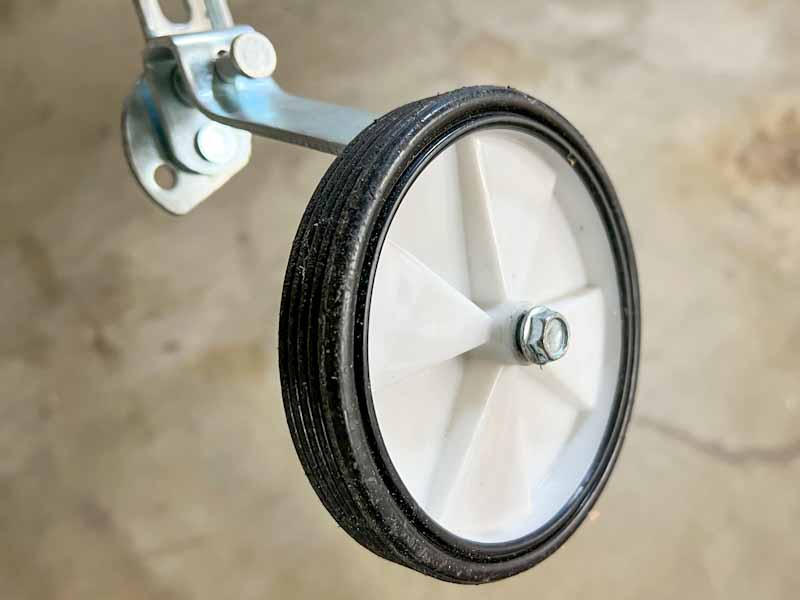
Because they’re so small (and because beginners often lean into them more than they should), training wheels can easily get caught on an uneven surface or any kind of debris. If your child is able to gain any momentum, training wheels can get caught and create an accident.
Better Options to Training Wheels
Balance Bike
Luckily there are some other options available if you want to teach your child to ride a bike. The first option, and the most common, is a balance bike.

A balance bike is a specially designed to not have pedals. It is considerably lighter and has the option to set the seat lower than a pedal bike. Balance bikes are a great tool for learning how to balance (hence the name). There are no pedals in the way and kids can just sit on them and go.
Balance bikes are a great option for young riders. You can start your child as young as 18 months old, and while they make larger models for older kids, they’re really best suited for kids up to 5 years old.
Balance bikes used to be an expensive niche option. One of the go-to balance bike options is made by Strider. A Strider 12 Classic goes for about $100 on Amazon. (If you do go for a Strider, I recommend the 12 Sport. It’s about $20 more but should last your child until they’re 5 compared to the Classic which adjusts for a 3 year-old).
Balance bikes have gotten popular enough that you can find a number of generic options on Amazon for as little as $60. More options also mean more difficulty picking the right one. If a balance bike sounds like an option for you, take a look at this article about what to look for in picking a balance bike.
This article is originally from www.dadstuffsite.com
Pedal Bike Without Pedals
A balance bike might be a great option for young riders, but what should you do if you child is older? Or maybe you already have a pedal bike for your child? Worry not! It isn’t too late and you didn’t waste your money.
If you have an older child that’s ready to ride a bike, then you can simply use a pedal bike, remove the pedals, and make it into a temporary balance bike. It’s a super easy process you can do in a couple minutes.
If you’re interested in learning how, check out Turn a Pedal Bike into a Balance Bike (In 5 Minutes or Less).
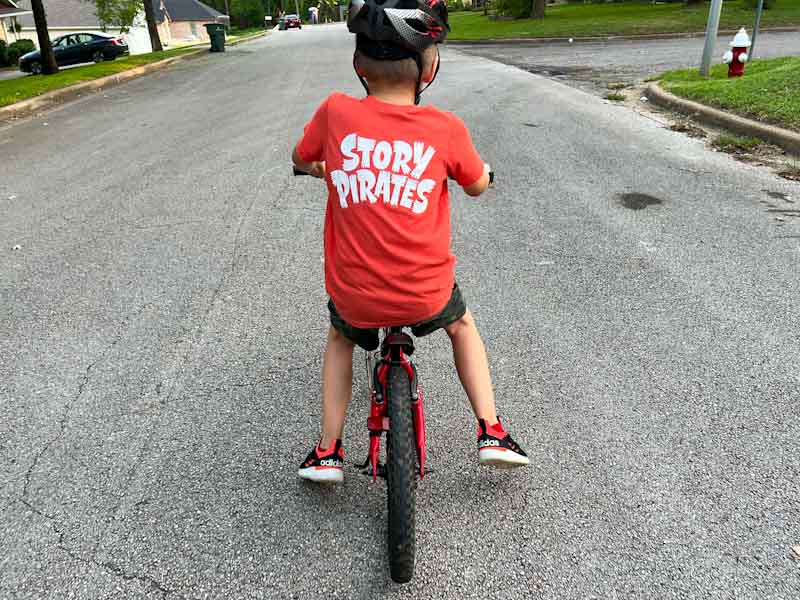
Your child can learn to balance the same way as they would with a balance bike but you don’t need to buy a special tool to learn how. With older children, once they learn to balance, you put the pedals back on, and they’re ready to learn to pedal.
To learn more, check out Teach an Older Child to Ride a Bike (What’s Different and Tips).
If you’re still unsure whether a balance bike or a regular bike without pedals is the right option for you, take a look at Balance Bike vs Bike Without Pedals (What’s Better?). I go into much more detail between the two options.
Related Posts
Teach an Anxious Child to Ride a Bike (In 9 Stress-Free Steps)
I’ve been a teacher for almost 20 years. It’s important to recognize that people learn in different ways and at different speeds. So when you watch that YouTube video that “guarantees” that...
I can hear it happening already. (Me using my best impression of my dad’s voice): “In my day, riding a bike was different.” And while I might weep a little as I slowly turn into a grumpy old...
